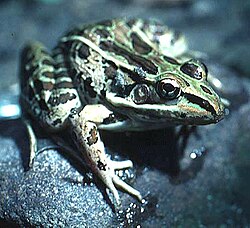| Forrer's grass frog | |
|---|---|
 | |
| Scientific classification | |
| Kingdom: | Animalia |
| Phylum: | Chordata |
| Class: | Amphibia |
| Order: | Anura |
| Family: | Ranidae |
| Genus: | Lithobates |
| Species: | L. forreri |
| Binomial name | |
| Lithobates forreri (Boulenger, 1883) | |
| Synonyms | |
Rana forreriBoulenger, 1883 | |
Forrer's grass frog or Forrer's leopard frog (Lithobates forreri) is a species of frog in the family Ranidae found in Mexico and Central America through Guatemala, El Salvador, Honduras, and Nicaragua to Costa Rica. [2] It is a widespread and common frog found in lowland and seasonal tropical forests. It can also adapt to man-made habitats such as flooded agricultural lands and other water content systems. Reproduction requires permanent pools and lagoons. [1]
